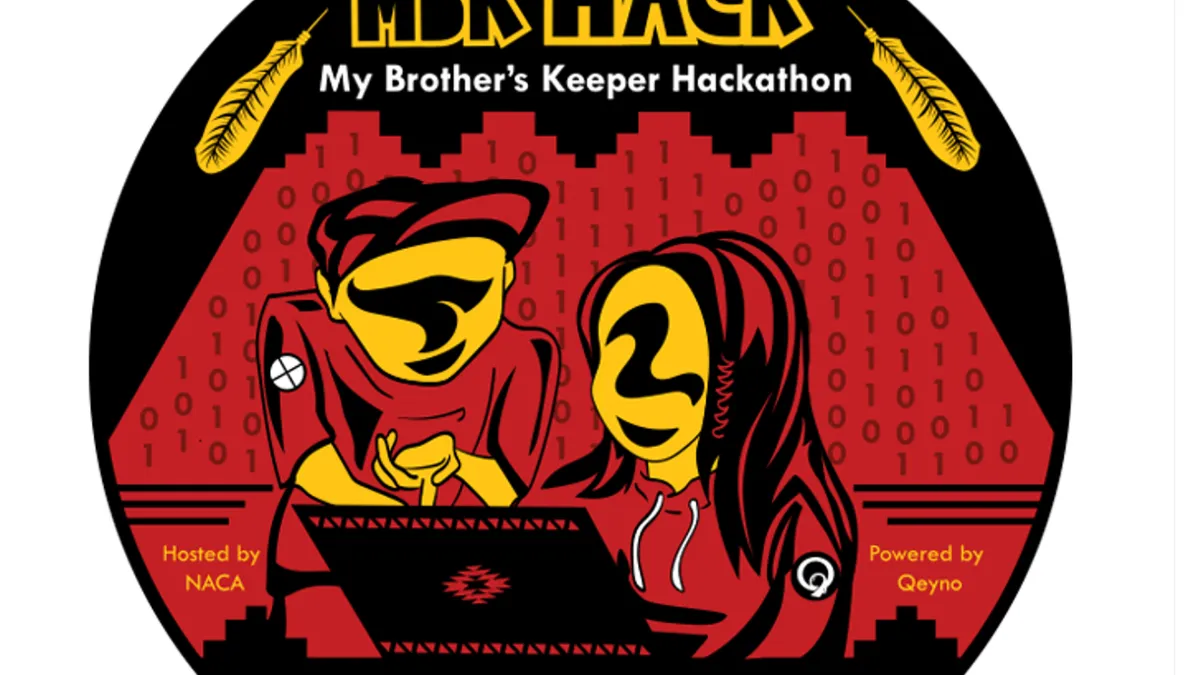Over the course of one weekend at the end of April in Albuquerque, NM, a few days of frantic organizing gave birth to the city’s first-ever Native Youth My Brother’s Keeper Hackathon, or #NativeMBK.
“It was a shoestring budget,” said Seth Saavedra, director of talent and advancement at Albuquerque’s Native American Community Academy. "We thought, let’s just make this happen. And it went serendipitously well."
The hackathon took place inside an open workspace called Epicenter, housed in a former church building, with 11 teams participating.
For the event, NACA partnered with Qeyno Labs, a Bay Area tech company known for a commitment to equity and access in tech for youth of color. Costs were also defrayed by funding from Teach for America’s Native Alliance Initiative, Central New Mexico’s STEMulus Center, Albuquerque Tech Startup of the Year Cultivating Coders, the McCune Foundation and many other organizations.
The office of Albuquerque Mayor Richard J. Berry also channeled federal funding from the My Brother’s Keeper initiative, launched by President Barack Obama in 2014, for the event.
“The #NativeMBK Hackathon is significant not only for the city but also for the state and nation because it marks a collaborative outreach to help engage and connect the Native American community to technology and innovation," an announcement from Berry's office read. The release noted the event's importance to building out the early stages of a web development workforce pipeline while helping to close a diversity gap in the tech field.
At the start of the weekend, students pitched ideas for products or services designed to provide solutions for their communities. Some were shy when addressing the crowd, Saavedra said, but pitches were thoughtful and delivered with impact. The ten best were chosen, and teams were assembled to execute plans for the concepts.
Both the first- and second-place projects both focused on representation of Native and Indigenous youth.
“Video games are hugely important to our students,” Saavedra said. “They’re fascinated by them. They don't see many accurate representations of themselves as Native students in the video games they love, so they decided to launch a game with accurate and relevant Native American representation.”
Watch the pitch from Major League Qeyno on the Acomo Pueblo Revolt game! They were our 1st place winners! #NativeMBK pic.twitter.com/9ZpUGE9oxX
— Qeyno Labs (@Qeyno) April 24, 2016
The game winning first place, Acoma Pueblo Revolt, was described as “the 'Oregon Trail' of Native games” by team mentor Julian Sutter, a marketing consultant and web designer. The concept reimagined the popular '90s educational game by creating an accurate portrayal of the Acoma Pueblo revolt, addressing colonization, resistance, organizers, protecting land, language and what happened in the Pueblo community.
Other hackathon projects included a a video game called The Battle for Jemhi, which also delves into colonization of and resistance by Indigenous peoples. Other games and apps sought to get youth physically active while playing, boost tech interest among Native American girls or create unique emojis (Unemojis) that would increase communication between cultures.
Still another website created during the hackathon set out to correct a "disheartening" lack of Native representation in sports.
“The Native presentation in sports video games is either lacking or incorrect," it states. "Some examples of Indigenous sports are Aztec Ullamaliztli Ball Game, Kamayura Woman Huka Huka Wreslting, Archery, Blowguns, Womans Log Carrying distance race, Iroquois Lacrosse, Muscogee Creek Stickball, Canoeing, Spear Throwing...”
Prizes ranged from gift cards to Amazon Fire Sticks to a day at a coding bootcamp.
The hackathon’s host, NACA, is a tuition-free charter school operating on the former site of the Albuquerque Indian School, a boarding school that assimilated Native youth into white culture from 1881 until its closure in 1982.
Today, nearly 400 students in grades 6 through 12 attend NACA. Youth come from diverse backgrounds, comprised of 40-50 different pueblos and tribes within a 50-mile radius.
Inside NACA's classrooms, students learn both American and global Indigenous policies, follow a rigorous college-prep study plan and study languages that include Navajo, Lakota, Spanish and Tiwa. The school also weaves community service into education and offers dual enrollment classes with the University of New Mexico and Central New Mexico Community College.
NACA also adopts a whole-child approach, with dental services offered onsite alongside other social services.
"As a school, we think about students holistically," Saaveda said. "Of course we have high academic rigor, and we're focused on college prep, but that lies in parallel with the importance of cultural identity, helping students find confidence in who they are, and of course wellbeing — physical and emotional."
"We work hard to ensure that our standard STEM curriculum and project based learning is relevant to our students, and their communities," he continued. "We ask: Is this relevant to the Pueblo communities? Culturally relevant education does not come at the cost of academic rigor."
The White House’s 2014 Native Youth Report defined Native American education as being in the midst of a "state of emergency." To help, the Obama administration launched Generation Indigenous, an initiative aiming to increase opportunities for Native American youth.
"Unlike achievement results for every other major ethnic group in the United States," a 2013 report by The Education Trust noted, "those for Native students have remained nearly flat in recent years, and the gaps separating these students from their white peers have actually widened." The National Assessment of Education Progress (NAEP) also reported that 69% of Native high school students were able to complete high school in four years, as compared to 83% of white students.
Yet events like the #NativeMBK aren't designed to end on Sunday night, when the hackathon wrapped up. The organizers committed to offering ongoing support. This summer, Central New Mexico’s STEMulus Center will offer coding bootcamps to anyone from the hackathon interested. And a new comprehensive computer science curriculum will be offered to current STEM teachers at NACA.
"There’s a huge craving and need for this within our students," Saavedra said. "It’s a viable career, and completely accessible from their communities."



















